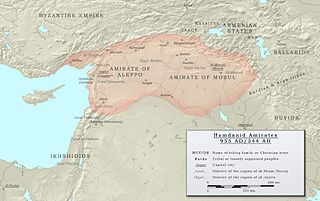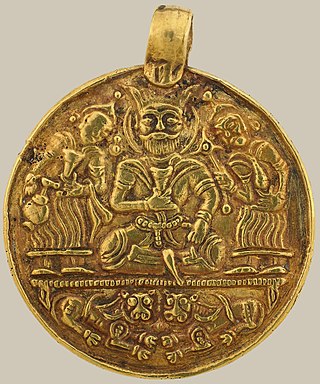
The Saffarid dynasty was a Persianate dynasty of eastern Iranian origin that ruled over parts of Persia, Greater Khorasan, and eastern Makran from 861 to 1002. One of the first indigenous Persian dynasties to emerge after the Islamic conquest, the Saffarid dynasty was part of the Iranian Intermezzo. The dynasty's founder was Ya'qub bin Laith as-Saffar, who was born in 840 in a small town called Karnin (Qarnin), which was located east of Zaranj and west of Bost, in what is now Afghanistan. A native of Sistan and a local ayyār, Ya'qub worked as a coppersmith (ṣaffār) before becoming a warlord. He seized control of the Sistan region and began conquering most of Iran and Afghanistan, as well as parts of Pakistan, Tajikistan and Uzbekistan.

The Buyid dynasty, also spelled Buwayhid, was a Zaydi and, later, Twelver Shia dynasty of Daylamite origin, which mainly ruled over Iraq and central and southern Iran from 934 to 1062. Coupled with the rise of other Iranian dynasties in the region, the approximate century of Buyid rule represents the period in Iranian history sometimes called the "Iranian Intermezzo".

The Hamdanid dynasty was a Shia Muslim Arab dynasty of Northern Mesopotamia and Syria (890–1004). They descended from the ancient Banu Taghlib tribe of Mesopotamia and Arabia.

The Ziyarid dynasty was an Iranian dynasty of Gilaki origin that ruled Tabaristan from 931 to 1090 during the Iranian Intermezzo period. The empire rose to prominence during the leadership of Mardavij. After his death, his brother Vushmgir and his Samanid allies led the dynasty in wrestling for control over territory against the Buyids in the early- to mid-10th century. When Vushmgir died, his sons Bisutun and Qabus fought for influence. Qabus would eventually outlive his brother and ruled the kingdom. However, Qabus was placed in exile from 980 to 998 by the Buyid ruler, Adud al-Dawla who would then dominate Tabaristan, the heartland of Ziyarid power. A succession of other rulers came to rule the kingdom with Ghaznavid support in the early 11th century. The Nizari Ismaili state invaded and ended Ziyarid rule in 1090.
Sayyida Shirin, also simply known as Sayyida (سیدا), was a Bavandid princess, who was the wife of the Buyid amir (ruler) Fakhr al-Dawla.

Abu Nasr Firuz Kharshadh, better known by his laqab of Baha al-Dawla was the Buyid amir of Iraq (988–1012), along with Fars and Kerman (998–1012). His early reign was dominated by struggles with his rival relatives over control of the western Persian provinces, but by 998 he managed to establish his supremacy over the Buyid confederation. His reign nevertheless saw the increasing encroachment of neighbouring powers on Buyid territory, and marks the beginning of the decline of the Buyids' power. He was the third son of 'Adud al-Dawla.

Abu Kalijar Marzuban, also known as Samsam al-Dawla was the Buyid amir of Iraq (983–987), as well as Fars and Kerman. He was the second son of 'Adud al-Dawla. The Abbasids recognized his succession and conferred upon him the title Samsam al-Dawla. He lacked the qualities of his father 'Adud al-Dawla and failed to have a grip upon his state affairs. His rule was marked by revolts and civil wars.

Abu Taher, better known by his regnal name Shams Al-Dawla, was the Buyid ruler of Hamadan from 997 to 1021. He was the son of Fakhr al-Dawla.

Hasan, better known by his laqab as Rukn al-Dawla, was the first Buyid amir of northern and central Iran. He was the son of Buya.

Abu Talib Rustam, commonly known by his laqab of Majd al-Dawla, was the last amir (ruler) of the Buyid amirate of Ray from 997 to 1029. He was the eldest son of Fakhr al-Dawla. A weak ruler, he was a figurehead most of his reign, whilst his mother Sayyida Shirin was the real ruler of the kingdom.

Fannā (Panāh) Khusraw, better known by his laqab of ʿAḍud al-Dawla was an emir of the Buyid dynasty, ruling from 949 to 983, and at his height of power ruling an empire stretching from Makran to Yemen and the shores of the Mediterranean Sea. He is widely regarded as the greatest monarch of the dynasty, and by the end of his reign he was the most powerful ruler in the Middle East.

The Marwanids or Dustakids were a Kurdish Sunni Muslim dynasty in the Diyar Bakr region of Upper Mesopotamia and Armenia, centered on the city of Amid (Diyarbakır).
The Annazids or Banu Annaz (990/991–1117) was a Kurdish Sunni Muslim dynasty which ruled an oscillating territory on the present-day frontier between Iran and Iraq for about 130 years. The Annazids were related by marriage to the Hasanwayhids who they were in fierce rivalry with. The legitimacy of the Annazid rulers stemmed from the Buyid amir Bahāʾ al-Dawla and the dynasty relied on the Shadhanjan Kurds.
Shabankara was an Iranian tribe. They claimed descent from the mythical Iranian king Manuchehr who had been deported to eastern Fars from Isfahan by the Buyid Shahanshah 'Adud al-Dawla. The dynasty's capital was Ij (Ig) and was divided in six districts: Zarkān, Iṣṭabānān, Burk-Tārum-K̲h̲ayra, Nayriz, Kurm-Rūnīz-Lār, and Darabjird. The tribe had the following subdivisions: Ismāʿīlī, the Rāmānī, the Karzuwī, the Masʿūdī and the S̲h̲akānī who were all herders and warriors.

Abu Muhammad al-Hasan ibn Abu'l-Hayja Abdallah ibn Hamdan al-Taghlibi, more commonly known simply by his honorific of Nasir al-Dawla, was the second Hamdanid ruler of the Emirate of Mosul, encompassing most of the Jazira.
Uddat al-Dawla Abu Taghlib Fadl Allah al-Ghadanfar al-Hamdani, usually known simply by his kunya as Abu Taghlib, was the third Hamdanid ruler of the Emirate of Mosul, encompassing most of the Jazira.

Muhammad ibn Rustam Dushmanziyar, also known by his laqab of Ala al-Dawla Muhammad, was a Daylamite military commander who founded in 1008 the short-lived but important independent Kakuyid dynasty in Jibal. He is also known as Pusar-i Kaku, Ibn Kakuyeh, Ibn Kakuya, and Ibn Kaku, which means maternal uncle in the Deylami language, and is related to the Persian word "kaka". Muhammad died in September 1041 after having carved out a powerful kingdom which included western Persia and Jibal. However, these gains were quickly lost under his successors.
Hasanwayh, also known as Abu'l-Fawaris, was the Kurdish founder of the Hasanwayhid dynasty, ruling from 961 to 979.

Badr ibn Hasanwayh was the second ruler of the Hasanwayhids from 979 to 1014. He was the son and successor of Hasanwayh.
Abu Ja'far al-Hajjaj ibn Ustadh Hurmuz was a Buyid general and governor.














